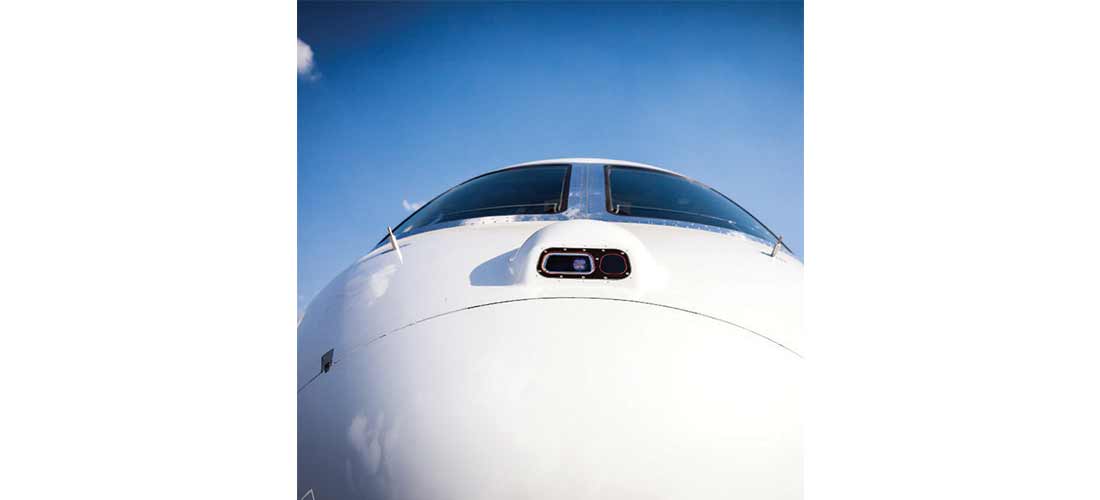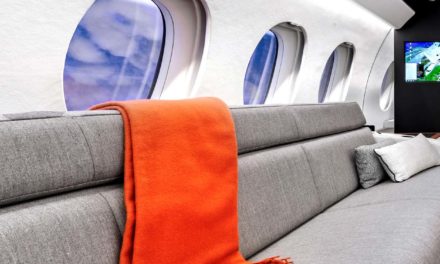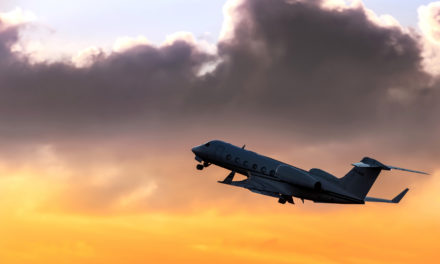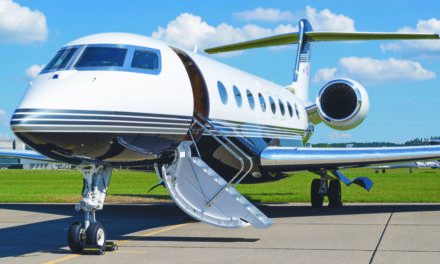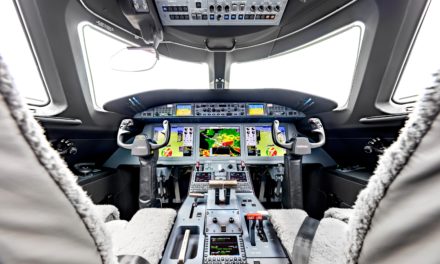We took a night flight on the Legacy 500 to test the EFVS (Enhanced Flight Vision System). The EFVS is the name given to the incorporation of an EVS (Enhanced Vision System) image on an HUD (Head Up Display).
The system frequently found on higher-end aircraft is a new feature in one more ways than one. It was designed and developed by Rockwell Collins. Our system is in part composed of the HGS3500, a HUD system used in the Legacy family and one of the most compact systems on the market. It directly displays the most important flight information in the pilot’s visual field and unlike traditional systems is not made up of a projector and a display system but rather is an all-in-one information display system. The reduced complexity, weight and volume allows it to be integrated in the “mid” and mid-light” aircraft, which is a first for these segments. The device also includes the EVS-3000 system composed of 3 cameras that provide clear images of the visual field at the front of the aircraft on the HUD and on the engine-indicating and crew-alerting system (EICAS) screen. The system functions regardless of the conditions, whether in rain storms or low visibility (fog). This new EVS has increased detection capacities of runway lighting systems using short-wave infrared and visible frequencies, as well as, technically challenging, LED lighting and sources of incandescent and halogen lighting (which in the context may cause glare for the pilot). The component uses electronic processing to represent an image surpassing the human eye. Moreover the system is the most light-weight and compact on the market. Since 2004, the FAA has allowed certain operators using the system to begin an approach regardless of the minimum RVR (Runway Visual Range) in line with the published approach minima. Pilots could continue their approach until 100 ft if the environment and the runway were visible using the EFVS then could proceed beyond that if they could see the runway without the system. EASA’s EU-OPS European regulation issued in 2008 authorized the same benefits to operators reducing the RVR conditions needed to start an approach by a third with EFVS equipment with the same requirement to have a visual at 100 feet from the ground. Since mid-March, the FAA (Federal Aviation Administration) and the ANAC (Brazilian civil aviation agency) approved the right to continue the approach within 100 feet using the EVS image on the HUD with for the moment a limit of 300m/1000ft of RVR to begin the approach. They also allowed the EFVS to be used to perform category II and III approaches to be continued until landing. The system has therefore revolutionized approaches in bad weather.
IN FLIGHT WITH THE SYSTEM
Our Legacy 500, registered PT-ZEY, is the test aircraft used in the development of the program. After take-off, we head north of Gaviao Peixoto which allows me to learn about the selections and fine-tune the system settings. We display the EVS image on the HUD on my left with the same EVS image displayed on my right on a half screen associated with the Primary Flight Display. The modes are selected using the CCD (Cursor Control Device) just like using a computer mouse and the brightness settings are selected directly on the HUD platform. We quickly arrive to the zone and descend to 3,500ft/ ground in this hilly region that has almost no lights. I can clearly distinguish the ground and contours of the terrain. The images in green tones displayed on the HUD provide an excellent rendering of the ground characteristics and are overset with the flight information providing me with a focused visual channel. The system ergonomics and in particular the simplicity of the image display, using a button on the side-stick, provides an optimal use of the EFVS. After around 20 minutes of circling the hills to view the system images, we head back for two approaches. On the first, we can clearly distinguish the contours of the runway despite the fact that the runway lights were switched off and the lack of moonlight. The “de-clutter” mode helps me to only see the information needed for the approach on the HUD and we descend to 100 ft where I switch to “view” and, with no visibility since the lights are switched off, we once again hit the gas. On our second approach, with the runway lights switched on, we continue under 100 ft with the system and the EVS image in the HUD offers welcome assistance for the landing. The EFVS system undoubtedly is a game changer for approaches in low visibility. Given the capacities of the system, its simplicity and how easy it is to use, in addition to the fact that it avoids the inconveniences of category 2 and 3 approaches – ground with fully compatible means of approach, equipped aircraft, trained crew – the choice of installing the system on this type of aircraft segment will allow clients improved access to “smaller airfields”. Especially those located in mountainous regions or prone to low visibility conditions that are not equipped with the necessary airfield equipment or infrastructure. Without a doubt, this system will soon become an important selling feature with the major promise of improving flight safety around the world.
By Greg Cellier
Copyright : Embraer

